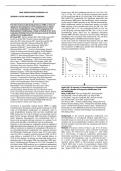Abstracts / Biol Blood Marrow Transplant 25 (2019) S7 S75 S7
ORAL PRESENTATIONS SESSIONS A-M hazard ratios (HR, 95% confidence intervals) of 1.19 (1.02-1.39),
1.26 (1.1-1.44), 1.51 (1.26-1.8). TBI was associated with a better
SESSION A: ACUTE AND CHRONIC LEUKEMIA OS, LFS and RI with HR of 0.75 (0.62-0.90), 0.70 (0.60-0.82) and
0.60 (0.49-0.74), respectively. No significant interaction was
found between MRD status and conditioning. When investigat-
7 ing the impact of MRD separately in the TBI and chemotherapy-
The Role of Measurable Residual Disease (MRD) at Time of based conditioning cohorts by multivariate analysis, we found
Allogeneic Hematopoietic Cell Transplantation in Adults MRD positivity to be associated with lower OS (HR 1.26, 1.05-
with Acute Lymphoblastic Leukemia Transplanted after 1.51) and LFS (HR 1.3,1.1-1.53), and higher RI (HR 1.53, 1.23-1.9)
Myeloablative Conditioning. A Study on Behalf of the Acute in the TBI group, and with higher RI (HR 1.58, 1.13-2.21) in the
Leukemia Working Party of the European Society for Blood chemotherapy group. There was no significant association
and Marrow Transplantation between MRD and other outcomes in this last cohort. TBI based
Jiri Pavlu MD1, Myriam Labopin MD2, Riitta Niittyvuopio MD3, conditioning was associated with improved OS, LFS, and RI in
Gerard Soci�e MD, PhD4, Ibrahim Yakoub-Agha MD, PhD5, both MRD negative and MRD positive patients (figure).
Depei Wu MD6, Peter Remenyi MD7, Jakob Passweg MD, MS8, In this large study we confirmed that patients who are MRD
Dietrich Beelen MD PhD9, Mahmoud Aljurf MD, MPH10, negative prior to HCT achieve superior outcomes. This is par-
Nicolaus Kro €ger MD11, H�el�ene Labussi�ere-Wallet MD12, ticularly apparent if TBI conditioning is used. All patients with
Sebastian Giebel MD13, Arnon Nagler MD, MSc14, ALL irrespective of MRD status benefit from TBI based condi-
Mohamad Mohty MD15. 1 Centre for Haematology, Imperial tioning in myeloablative setting.
College at Hammersmith Hospital, London, United Kingdom;
2
Department of Hematology and EBMT Paris study office /
CEREST-TC, Saint Antoine Hospital, Paris, France; 3 Stem Cell
Transplantation Unit, HUCH Comprehensive Cancer Center,
Helsinki, Finland; 4 Hematology BMT, Saint Louis Hospital,
Paris, France; 5 HURIEZ UAM allo-CSH Hospital, CHRU, Lille,
France; 6 Department of Hematology, the First Affiliated Hospital
of Soochow University, Soochow, China; 7 Department of
Hematology and Stem Cell Transplantation, D�el-pesti
Centrumko �z Orsza
�rha �gos Hematolo �giai �es Infektolo
�giai Int�ezet,
Budapest, Hungary; 8 University Hospital Basel, Basel,
Switzerland; 9 Department of Bone Marrow Transplantation,
West German Cancer Center, University Hospital of Essen, Essen,
Germany; 10 Department of Oncology, King Faisal Specialist
Hospital & Research Center, Riyadh, Saudi Arabia; 11 Department
of Stem Cell Transplantation, University Medical Center
Hamburg-Eppendorf, Hamburg, Germany; 12 Service
Hematologie, Centre Hospitalier Lyon Sud, Lyon, France;
8
13 Haplo-HSCT Is Superior to Chemotherapy for Standard Risk
Department of Bone Marrow Transplantation and
Oncohematology, Maria Sklodowska-Curie Memorial Cancer ALL in CR1—Results of Prospective Multicenter Trial
Center and Institute of Oncology, Gliwice Branch, Gliwice, Poland; (NCT02042690)
14
The Chaim Sheba Medical Center, Tel-Hashomer, Division of Meng Lv MD, Ph D1, Xiao-jun Huang MD1, Qian Jiang MD1,
Hematology and Bone Marrow Transplantation, Ramat-Gan, Hao Jiang MD1, Xiao-hui Zhang MD1, Lan-ping Xu MD1,
Israel; 15 Department of Haematology and EBMT Paris study office Yu Wang MD1, Ying-Jun Chang MD, PhD1, Kai-yan Liu MD1,
/ CEREST-TC, Saint Antoine Hospital, INSERM UMR 938 and Dao-bin Zhou MD2, Yu Hu MD3, Depei Wu MD4,
Universit�e Pierre et Marie Curie, Paris, France Dai-hong Liu MD5. 1 Institute of Hematology, Peking University
People’s Hospital, Beijing, China; 2 Peking Union Hospital, Beijing,
Assessment of measurable residual disease (MRD) is rapidly China; 3 Wuhan Union Hospital, Wuhan, China; 4 Department of
transforming the therapeutic and prognostic landscape of a wide Hematology, the First Affiliated Hospital of Soochow University,
range of hematological malignancies. Its prognostic value in Soochow, China; 5 Institute of Hematology, General Hospital of
acute lymphoblastic leukemia (ALL) has been established and PLA, Beijing, China
MRD measured at the end of induction is increasingly used to
guide further therapy. Although MRD detectable immediately Background: In the present prospective multicenter trial
before allogeneic hematopoietic cell transplantation (HCT) is (NCT02042690), we investigated whether haplo-HSCT has a
known to be associated with poor outcomes, it is unclear if or to favorable impact on survival as post remission treatment for
what extent this differs with different types of conditioning. standard risk acute lymphoblastic leukemia (ALL) patients in
Therefore, in this retrospective multicenter study we explored if the first complete remission (CR1) by comparing with chemo-
MRD detectable before allogeneic HCT for ALL is associated with therapy alone.
different outcomes in recipients of myeloablative TBI-based ver- Methods: £°Inclusion criteria of ALL:(1) age 18 to 39 years;
sus chemotherapy-based conditioning. We analyzed outcomes (2) without high-risk features, which consisted of elevated
of 2780 patients (median age 38 years, range 18-72) who under- WBC count(>30 *109/L for B cell lineage or >100 *109/L
went first HCT in complete remission between 2000 and 2017 for T cell lineage), or high-risk cytogenetic abnormalities,
using sibling or unrelated 9/10 or 10/10 matched donors. In determined according to the National Comprehensive Can-
1816 of these patients no disease was detectable before trans- cer Network 2013 guidelines; and (3) achieving CR after 1
plantation and in 964 patients MRD was detectable (MRD posi- to 2 cycles of induction. Subjects without a suitable HLA
tivity). Conditioning was TBI-based in 2122 (76%) transplants. In matched sibling (MSD) or HLA-matched unrelated donor
the whole cohort MRD positivity was a significant independent �
(!Y8/10 URD) after 2 cycles of consolidation (Hyper-CVAD
factor for lower overall survival (OS) and leukemia-free survival B/A*1) were eligible for haplo-HSCT or further chemother-
(LFS), and for higher relapse incidence (RI), with respective apy (Hyper-CVAD B/A*3). Landmark analysis (4 months




